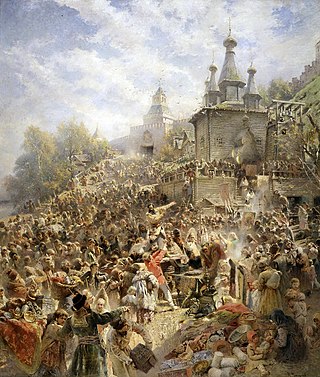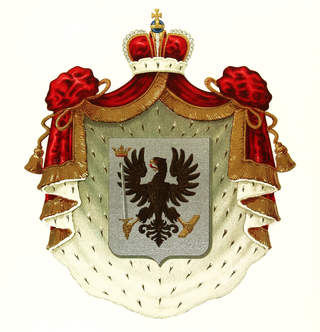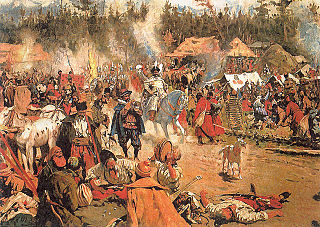
The Time of Troubles, or Smuta, was a period of political crisis in the Tsardom of Russia which began in 1598 with the death of Feodor I, the last of the Rurik dynasty, and ended in 1613 with the accession of Michael I of the House of Romanov.

Dmitry Mikhaylovich Pozharsky was a Russian prince known for his military leadership during the Polish–Muscovite War from 1611 to 1612. Pozharsky formed the Second Volunteer Army with Kuzma Minin in Nizhny Novgorod against the Polish–Lithuanian Commonwealth's occupation of Russia during the Time of Troubles, resulting in Polish withdrawal after Russian victory at the Battle of Moscow in 1612. Pozharsky received the unprecedented title of Saviour of the Fatherland from Mikhail I of Russia, becoming a folk hero in Russian culture and honored in the Monument to Minin and Pozharsky in Moscow's Red Square.

Vasili IV Ivanovich Shuisky was Tsar of all Russia from 1606 to 1610, after the murder of False Dmitri I. His rule coincided with the Time of Troubles. He was the only member of House of Shuisky to become tsar and the last member of the Rurikid dynasty to rule as tsar.

False Dmitry II, historically known as Pseudo-Demetrius II and also called tushinsky vor, was the second of three pretenders to the Russian throne who claimed to be Tsarevich Dmitry Ivanovich, the youngest son of Ivan the Terrible, during the Time of Troubles. The real Dmitry had died under uncertain circumstances, most likely an assassination in 1591 at the age of nine at his widowed mother's appanage residence in Uglich.

The Polish–Muscovite War of 1605–1618, also known as the Polish–Muscovite War or the Dimitriads, was a conflict fought between the Tsardom of Russia and the Polish–Lithuanian Commonwealth together with Zaporozhian Cossacks from 1605 to 1618.

Prokopy Petrovich Lyapunov was a prominent 17th century Russian nobleman (dvoryanin), voivode of, allegedly, a Rurikid origin who practically became a head of Pereyaslavl-Ryazansky lands nobility in the end of 1590s; he took part in wars during power vacuum in succession crisis that happened in early 1598 in Tsardom as result of confusion about legitimate heir apparent following death of Feodor I, nobility infighting, war declared by Polish–Lithuanian Commonwealth (PLC) in 1605, and exhaustive Tatar raids; most famously he is remembered for organizing and leading the first unsuccessful uprising against occupation of Moscow of 1610 by PLC in April of 1611.

Prince Mikhail Vasiliyevich Skopin-Shuisky was a Russian statesman and military figure during the Time of Troubles. He was the last representative of a cadet branch of the Shuysky family.

Ivan Tarasyevich Gramotin was a Russian diplomat and head of the Posolsky Prikaz.

Kuzma Minin, full name Kuzma Minich Zakhariev-Sukhoruky, was a Russian merchant who, together with Prince Dmitry Pozharsky, organized a people's militia in Nizhny Novgorod to oust the Poles from Moscow in 1612. As a result, they became national heroes for their role in defending the country.

Prince Dmitry Timofeyevich Troubetzkoy was a Russian military and political figure during the Time of Troubles, one of the leaders in a rebellion against the Polish occupation and the leader of the Zemsky Sobor's provisional government.
Nikita Romanovich, also known as Nikita Romanovich Zakharyin-Yuriev, was a prominent boyar of the Tsardom of Russia. His grandson Michael I founded the Romanov dynasty of Russian tsars.
The Seven Boyars were a group of Russian nobles who deposed Tsar Vasily Shuisky on 17 July 1610 and, later that year, invited the Poles into Moscow.

Michael I was Tsar of all Russia from 1613 until his death after being elected by the Zemsky Sobor. He was the first tsar of the House of Romanov, which succeeded the House of Rurik.

The Battle of Moscow was a series of two battles, which took place in Moscow, on September 1 and 3, 1612, during the Polish–Muscovite War (1605–18), and Time of Troubles. Forces of the Polish–Lithuanian Commonwealth were commanded by Field Hetman of Lithuania, Jan Karol Chodkiewicz, while the Russians were led by Dmitry Pozharsky. The battles ended in tactical Russian victories.
The Story of the Victories of the Moscow State, also known as The Tale of the Victories of the Moscow State, is a Russian literary work of the 17th century, a historical tale of the events of the Time of Troubles, mainly about the campaigns of the Smolensk noble militia and the struggle of the Smolensk nobles with Poles and supporters of False Dmitry.
Prince Vasily Vasilievich Golitsyn was a Russian commander, nobleman and governor. Golitsyn was a prominent figure during the Time of Troubles between 1587 and 1613.

The Zemsky Sobor of 1613 was a meeting of representatives of the Estates of the realm of the Tsardom of Russia, held for the election of Tsar after the expulsion of the Polish-Lithuanian Occupiers at the end of the Time of Troubles. It was opened on 16 January 1613 in the Assumption Cathedral of the Moscow Kremlin. On 3 March 1613, the Sobor elected Mikhail Romanov as Tsar, establishing the House of Romanov as the new Russian monarchs. The coronation of Michael I is widely considered to be the end of the time of troubles.

Wigund-Jeronym Trubecki or Yuri Nikitich Trubetsky as he was called earlier in Muscovy was the Prince of Trubetsk from 1611 to 1634, preceded by Symeon Iwanowicz Perski Trubecki, succeeded by Piotr Trubecki, and Aleksander Trubecki. Yuri Nikitich Trubetsky was also a boyar and equestrian of False Dmitry II. After emigrating to Poland, and restoring The Principality of Trubetsk, he converted to Catholicism, and took the name Wigund-Jeronym Trubecki.
Godunov is a Russian historical drama television series created by Ilya Tikin and Nikolay Borisov, directed by Alexei Andrianov and Timur Alpatov. The first season premiered from November 5 to November 8, 2018 on the "Russia-1" national TV channel. The second season premiered from March 25 to March 29, 2019.

The Tushino Camp was the camp of False Dmitry II near the village of Tushino near Moscow, which from June 1608 to December 1609 served as the capital of this impostor, who, as a result, received the name "Tushino Thief". All those dissatisfied with the elected Tsar Vasily Shuisky, flocked to the Tushino Camp, which made it a shadow capital with its own state institutions, a patriarch, and so on. From December 1609 to March 1610, the Tushino Camp supported the Polish King Sigismund.














